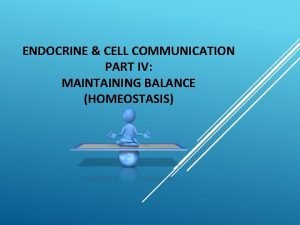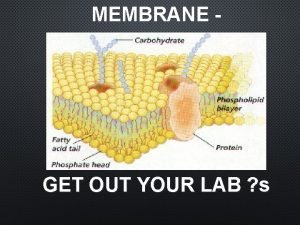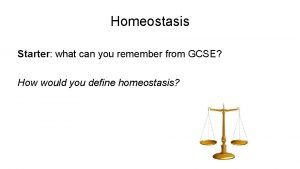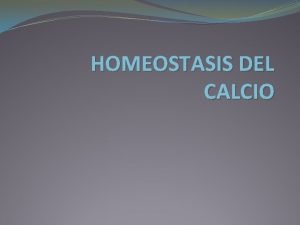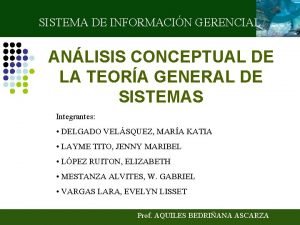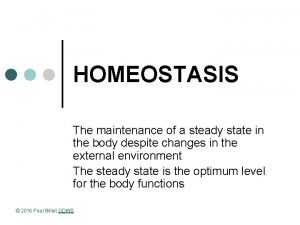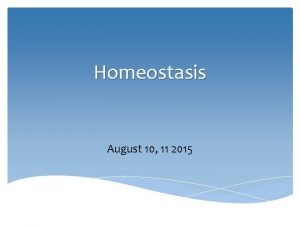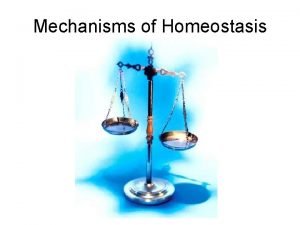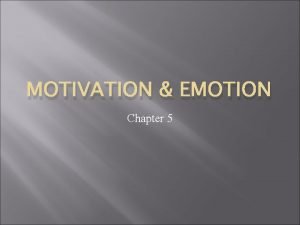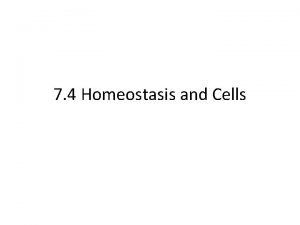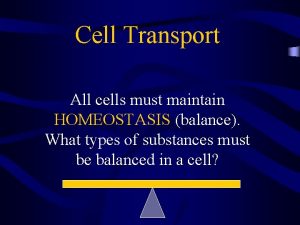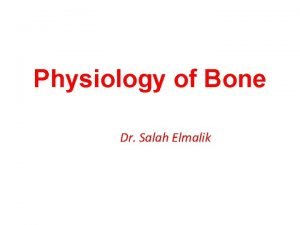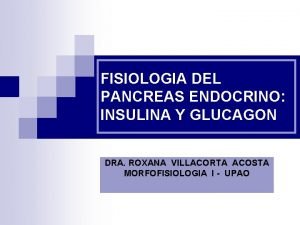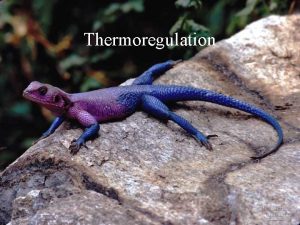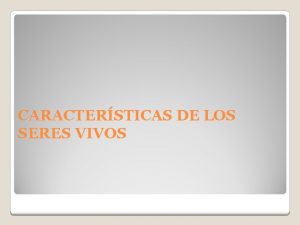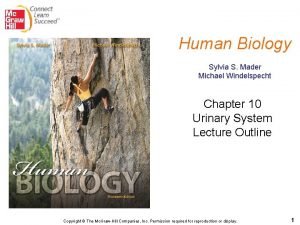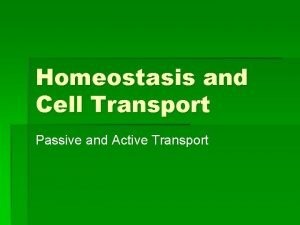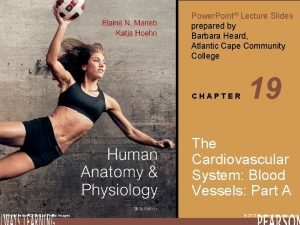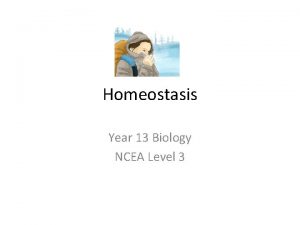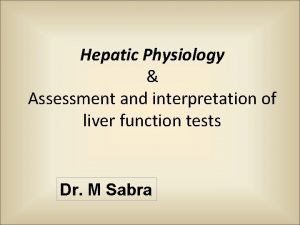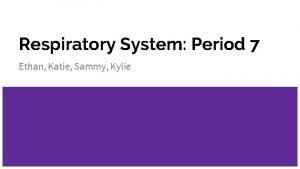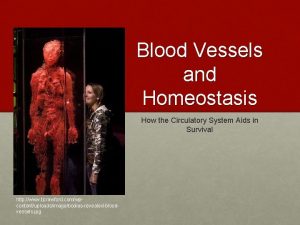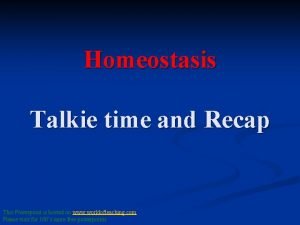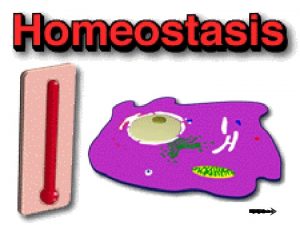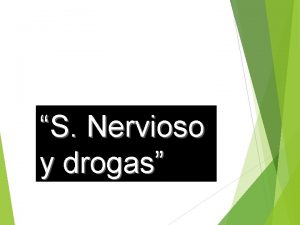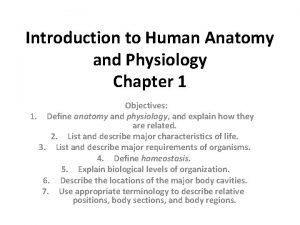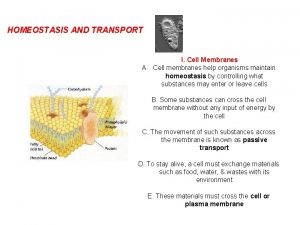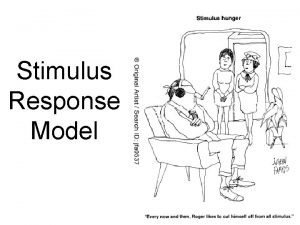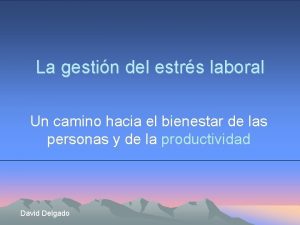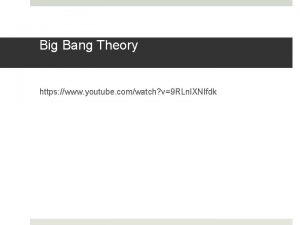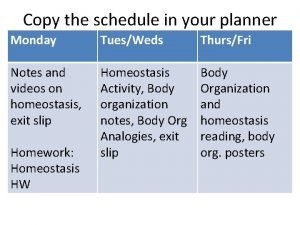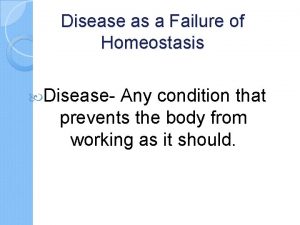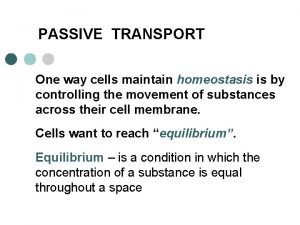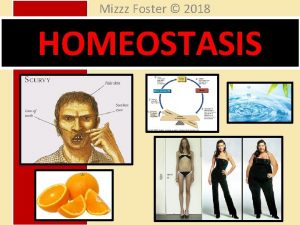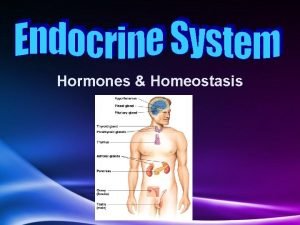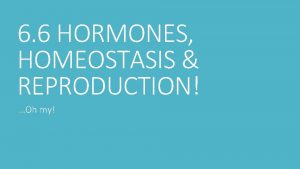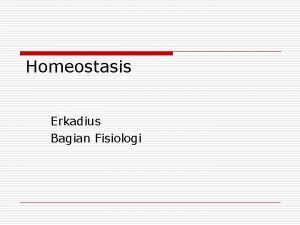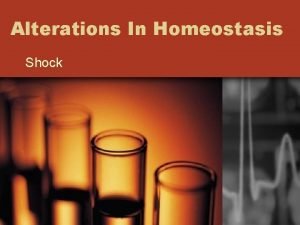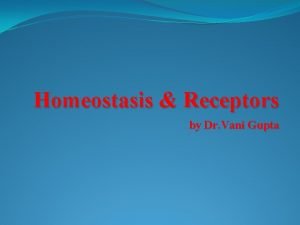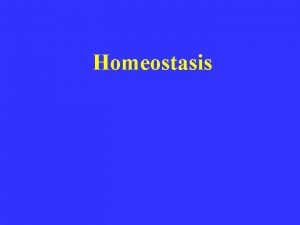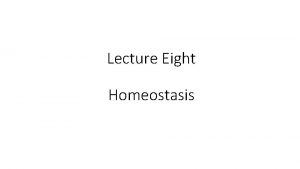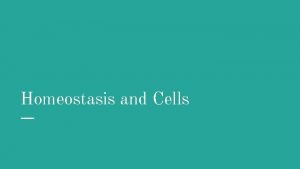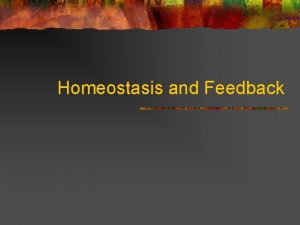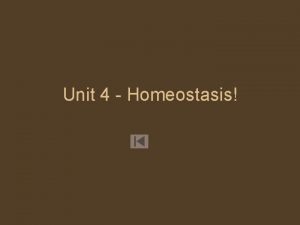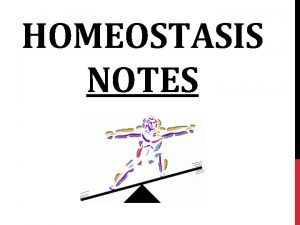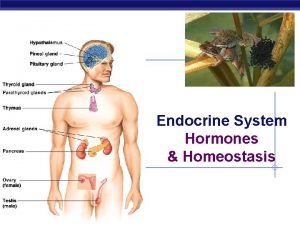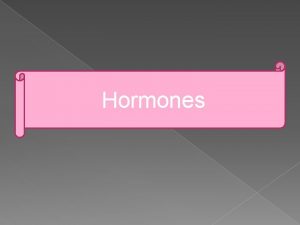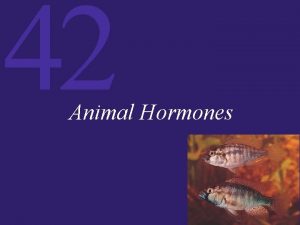HORMONES HOMEOSTASIS REPRODUCTION Hormones are used when signals















































- Slides: 47

HORMONES, HOMEOSTASIS & REPRODUCTION Hormones are used when signals need to be widely distributed. Topic 6. 6 IB Biology Miss Werba J WERBA – IB BIOLOGY 1

TOPIC 6 – HUMAN PHYSIOLOGY 6. 1 DIGESTION & ABSORPTION 6. 6 6. 2 HORMONES, HOMEOSTASIS & REPRODUCTION THE BLOOD SYSTEM 6. 3 6. 5 DEFENCE AGAINST INFECTIOUS DISEASE NEURONS & SYNAPSES 6. 4 GAS ECHANGE J WERBA – IB BIOLOGY 2

THINGS TO COVER Statement Guidance U. 1 Insulin and glucagon are secreted by β and α cells of the pancreas respectively to control blood glucose concentration. U. 2 Thyroxin is secreted by the thyroid gland to regulate the metabolic rate and help control body temperature. U. 3 Leptin is secreted by cells in adipose tissue and acts on the hypothalamus of the brain to inhibit appetite. U. 4 Melatonin is secreted by the pineal gland to control circadian rhythms. U. 5 A gene on the Y chromosome causes embryonic gonads to develop as testes and secrete testosterone. U. 6 Testosterone causes pre-natal development of male genitalia and both sperm production and development of male secondary sexual characteristics during puberty. U. 7 Oestrogen and progesterone cause pre-natal development of female reproductive organs and female secondary sexual characteristics during puberty. U. 8 The menstrual cycle is controlled by negative and positive feedback mechanisms involving ovarian and pituitary hormones. J WERBA – IB BIOLOGY The roles of FSH, LH, estrogen and progesterone in the menstrual cycle are expected. 3

THINGS TO COVER Statement Guidance A. 1 Causes and treatment of Type I and Type II diabetes. A. 2 Testing of leptin on patients with clinical obesity and reasons for the failure to control the disease. A. 3 Causes of jet lag and use of melatonin to alleviate it. A. 4 The use in IVF of drugs to suspend the normal secretion of hormones, followed by the use of artificial doses of hormones to induce superovulation and establish a pregnancy. William Harvey failed to solve the mystery of sexual reproduction because effective microscopes were not available when he was working, so fusion of gametes and subsequent embryo development remained undiscovered. A. 5 William Harvey’s investigation of sexual reproduction in deer. S. 1 Annotate diagrams of the male and female reproductive system to show names of structures and their functions. NOS Developments in scientific research follow improvements in apparatus — William Harvey was hampered in his observational research into reproduction by lack 1. 8 of equipment. The microscope was invented 17 years after his death. J WERBA – IB BIOLOGY 4

THE ENDOCRINE SYSTEM � The endocrine system consists of glands that release hormones that are transported in the blood. � Produces J WERBA – IB BIOLOGY slow responses 5

HOMEOSTASIS � Homeostasis involves maintaining the internal environment between narrow limits � Feedback loops control homeostasis � Feedback can be positive or negative � Negative feedback: ◦ more common ◦ has a stabilising effect ◦ changes are reversed J WERBA – IB BIOLOGY 6

U. 1 CONTROL OF BLOOD GLUCOSE � Control of blood glucose concentration involves the insulin and glucagon hormones � Secreted by the pancreas � Insulin secreted by β cells lowers blood glucose levels � Glucagon secreted by α cells raises blood glucose levels J WERBA – IB BIOLOGY 7

U. 1 CONTROL OF BLOOD GLUCOSE Detected by hypothalamus Blood sugar rises Normal blood glucose level (90 mg/100 m. L) Blood sugar falls Detected by hypothalamus J WERBA – IB BIOLOGY cells secrete insulin, glucose glycogen Blood glucose concentration falls Blood glucose concentration rises α cells secrete glucagon, glycogen glucose 8

A. 1 DIABETES � The failure to control blood glucose level � Leads to hyperglycaemia, abnormally high levels of glucose in the blood � The kidney cannot reabsorb all of the glucose any longer, so it is excreted in the urine. � Urine volume increases leads to thirst � Muscle tissue is broken down leads to weight loss � May impair vision � May lead to kidney failure � There are two types of diabetes J WERBA – IB BIOLOGY 9

U. 1 DIABETES Type I diabetes: � Early onset (usually childhood) � Due to loss of insulin secreting cells in the pancreas � No insulin produced (autoimmune? ) � Controlled by regular insulin injections; pancreas transplant � Potential for stem cell therapy – researchers have successfully produced human beta cells from embryonic SC and are now doing animal trials in order to test their use as a treatment for diabetes J WERBA – IB BIOLOGY 10

U. 1 DIABETES Type II diabetes: � Late onset (usually adulthood) � Commonly associated with being overweight for a long period of time � Caused by reduced sensitivity of the insulin target cells they don’t take up sufficient glucose to reduce the levels in the blood � Controlled through dietary measures, increased activity and/or medication WERBA ––IBIBBIOLOGY JJ WERBA BIOLOGY 11 11

CONTROL OF METABOLIC RATE & TEMPERATURE U. 2 � Control of metabolic rate and temperature involves the thyroxin hormone � Secreted by the thyroid � Release is controlled by the hypothalamus in the brain � Prolonged exposure to cold will stimulate the hypothalamus to trigger the release of thyroxin from the thyroid gland � Metabolic product. WERBA ––IBIBBIOLOGY JJ WERBA BIOLOGY rate will increase, generating heat as a by 12 12

CONTROL OF METABOLIC RATE & TEMPERATURE U. 2 J WERBA – IB BIOLOGY 13

CONTROL OF METABOLIC RATE & TEMPERATURE U. 2 Detected by hypothalamu s Increase in body temp Detected by hypothalamu s J WERBA – IB BIOLOGY -ve feedback of thyroxin, no thyroxin produced, reduced metabolism, sweating, vasodilation, hair or feathers lie flat, behaviour changes Normal body temperature (37°C) Body temp falls thyroxine produced by thyroid, increased metabolism, no sweating, piloerection, vasoconstriction, shivering, behaviour changes Body temp rises 14

U. 3 CONTROL OF APPETITE � Control of appetite involves the leptin hormone � Secreted by the adipose (fat) cells � It regulates the amount of fat stored in the body in order to regulate energy levels � When the adipose tissue reaches a certain level, leptin is released. � It acts on the hypothalamus that then inhibits appetite and increases metabolism. J WERBA – IB BIOLOGY 15

U. 3 CONTROL OF APPETITE J WERBA – IB BIOLOGY 16

A. 2 OBESITY � Clinical obesity = BMI over 30 kg m-2 mutated leptin gene � Obese patients generally have higher leptin levels than a non-obese person. � This does not match expectations. � One hypothesis is that in these cases, there is a fault in the leptin-receptor on the cells of the hypothalamus. � Leptin injections will therefore not work to reduce hunger. J WERBA – IB BIOLOGY 17

CONTROL OF CIRCADIAN RHYTHMS U. 4 � Control of circadian rhythms involves the melatonin hormone � Secreted by the pineal gland in the brain � The secretion of melatonin follows a regular pattern to control the sleep/wake cycle � High secretion at night, low during the day � Maintained � On by the natural light-dark cycle average, children release more melatonin than adults J WERBA – IB BIOLOGY 18

CONTROL OF CIRCADIAN RHYTHMS J WERBA – IB BIOLOGY U. 4 19

A. 3 JET LAG � Caused by rapid travel across time zones � Travelling � The disrupts the normal circadian rhythms brain resets to the new rhythm � The more time zones that have been crossed, the longer it will take to reset. � Melatonin tablets can be used to alleviate jet lag – but their efficacy has not been proven since dosage and timing are highly variable. � Spending some time looking at the moon has also been known to help recovery from jet lag. J WERBA – IB BIOLOGY 20

MALE REPRODUCTIVE SYSTEM E T A OT N N A ! S. 1 bladder vas deferens seminal vesicles prostate gland Cowper’s gland urethra scrotum penis epididymis testis (pl. testes) J WERBA – IB BIOLOGY 21

S. 1 MALE REPRODUCTIVE SYSTEM � Testis: produces sperm & testosterone � Scrotum: keeps testes at a lower temperature � Epididymis: temporary storage of sperm during maturation � Vas deferens: transfers sperm during ejaculation � Seminal vesicle: produces some of the fluid making up semen � Prostate gland: produces some of the fluid making up semen � Penis: enters vagina to release semen near cervix during ejaculation � Erectile tissue: fills with blood to produce an erection � Urethra: transports urine and semen J WERBA – IB BIOLOGY 22

S. 1 FEMALE REPRODUCTIVE SYSTEM ANNO Fallopian tube (oviduct) ! TATE funnel ovary ovarian ligament uterus endometrium uterine wall cervix vagina vulva J WERBA – IB BIOLOGY 23

S. 1 FEMALE REPRODUCTIVE SYSTEM � Ovary: releases one secondary oocyte once a month; releases progesterone and oestrogen � Oviduct: picks up secondary oocyte at ovulation; site of fertilisation; responsible for transporting the blastocyst to the uterus � Uterus: place where foetus grows � Endometrium: lining of the uterus which is shed and replaced during menstruation; site of implantation of the blastocyst � Cervix: neck of uterus; plugged by mucous during pregnancy � Vagina: region where semen is deposited during intercourse; birth canal. J WERBA – IB BIOLOGY 24

U. 5 REPRODUCTIVE HORMONES J WERBA – IB BIOLOGY 25

U. 5 REPRODUCTIVE HORMONES � During foetal development, the gonads develop close to the kidney. �A gene on the Y chromosome causes embryonic gonads in the male to develop as testes and move into the scrotum. � The testes start to secrete testosterone. This causes the external genitalia to develop. J WERBA – IB BIOLOGY 26

U. 6 TESTOSTERONE Functions: � pre-natal development of male genitalia � development of male secondary sexual characteristics during puberty � stimulates the final stages of spermatogenesis (sperm production) J WERBA – IB BIOLOGY 27

OESTROGEN and PROGESTERONE U. 7 Functions: � pre-natal development of female genitalia � development of female secondary sexual characteristics during puberty J WERBA – IB BIOLOGY 28

U. 8 HORMONES & MENSTRUATION � There are 4 hormones involved in controlling the monthly cycle: ◦ FSH – Follicle Stimulating Hormone ◦ LH – Luteinising Hormone ◦ Progesterone ◦ Oestrogen Ovary J WERBA – IB BIOLOGY Pituitary gland 29

U. 8 HORMONES & MENSTRUATION 1) Pituitary gland (in the brain) releases FSH: stimulates the growth of the follicle stimulates oestrogen production by the follicle 2) The growing follicle (in the ovary) releases oestrogen: increases endometrium thickness inhibits FSH production (-ve feedback) stimulates LH production (+ve feedback) J WERBA – IB BIOLOGY 30

U. 8 HORMONES & MENSTRUATION 3) Pituitary gland releases LH: stimulates ovulation (+ve feedback) stimulates corpus luteum formation stimulates oestrogen and progesterone production by the corpus luteum 4) The corpus luteum (in the ovary) produces progesterone: maintains endometrium inhibits FSH production (-ve feedback) inhibits LH production (-ve feedback) J WERBA – IB BIOLOGY 31

U. 8 HORMONES & MENSTRUATION � If fertilisation of egg occurs, the zygote releases a hormone (h. CG) which maintains the corpus luteum � If fertilisation does not occur: ◦ the corpus luteum degenerates ◦ FSH inhibition by progesterone is lost ◦ the pituitary will start producing FSH again to stimulate another follicle J WERBA – IB BIOLOGY 32

HYPOTHALAMUS FSH LH Pituitary Gland (Anterior Lobe) Inhibits FSH & LH Stimulates LH Growing follicle Ovulation Corpus luteum Ovaries OESTROGEN PROGESTERONE Builds up endometrium Maintains endometrium 1 JMenstruation WERBA – IB BIOLOGY 7 14 28 time/days Menstruation 33

U. 8 HORMONES & MENSTRUATION Hormone FSH Source Pituitary Stimulates follicle growth Stimulates oestrogen secretion Functions Stimulates progesterone secretion FSH surge stimulates ovulation OESTROGEN Ovary (follicle) Stimulates thickening of endometrium Promotes secondary sexual characteristics (eg. breast development, widening of hips) Stimulates LH secretion LH Pituitary LH surge stimulates ovulation Stimulates corpus luteum formation PROGESTERONE Ovary (corpus luteum) Inhibits ovulation Maintains endometrium Inhibits FSH secretion Inhibits LH secretion Inhibits FSH secretion J WERBA – IB BIOLOGY 34

J WERBA – IB BIOLOGY 35

U. 4 IN VITRO FERTILISATION (IVF) � IVF = in vitro fertilisation ◦ ‘in vitro’ literally means ‘in glass’ � In this procedure, the egg and the sperm meet outside the female’s body. � First “test tube baby” was Louise Brown, born in 1978. J WERBA – IB BIOLOGY 36

U. 4 IN VITRO FERTILISATION (IVF) Process: 1. Drugs are used to suspend the normal secretion of hormones. 2. Drugs are used to down-regulate the menstrual cycle: ◦ FSH injected stimulates development of multiple follicles and induce superovulation ◦ h. CG injected causes follicles to mature 3. Eggs are harvested/extracted (from the mature follicles/ovaries) J WERBA – IB BIOLOGY 37

U. 4 IN VITRO FERTILISATION (IVF) Process: 4. Semen sample collected and processed to concentrate it. 5. Healthy sperm is selected. 6. Semen is brought into contact with the egg to allow fertilization: ◦ sperm is directly injected into egg when low numbers or motility are a factor ◦ semen is mixed with eggs in a dish/outside the body J WERBA – IB BIOLOGY 38

U. 4 IN VITRO FERTILISATION (IVF) Process: 7. Incubated at 37°C to allow embryos to develop 8. Dish examined to choose healthiest embryo (eg. karyotyping and/or gene probes); 9. More hormones are used to prepare the mother’s uterus (eg. progesterone, h. CG) 10. Embryo(s) are placed in uterus/oviduct, using a catheter or frozen so that they can be used later 11. Pregnancy test/scan used to assess success. J WERBA – IB BIOLOGY 39

U. 4 IN VITRO FERTILISATION (IVF) J WERBA – IB BIOLOGY 40

TECHNOLOGY ENABLES DEVELOPMENTS IN RESEARCH NOS 1. 8 Developments in scientific research follow improvements in apparatus. William Harvey was hampered in his observational research into reproduction by lack of equipment. The microscope was invented 17 years after his death. J WERBA – IB BIOLOGY 41

A. 5 WILLIAM HARVEY’S RESEARCH � Harvey investigated human circulation (Topic 6. 2) and sexual reproduction. � He observed growth in fertilised hens’ eggs, as these were large and easy to obtain and observe. He made connections between a drop of blood on the yolk and the growth of new chick. � He observed that deer needed to mate before any offspring could be produced. Observations of the uteruses of some of these deer showed that the embryo only appeared a couple of months after mating. This led to false conclusions about the lack of importance of the male ‘seed’. J WERBA – IB BIOLOGY 42

A. 5 WILLIAM HARVEY’S RESEARCH � William Harvey failed to solve the mystery of sexual reproduction because effective microscopes were not available when he was working. � Fusion of gametes and embryonic development remained undiscovered. � Sperm were first observed in 1677. � Harvey had passed away in 1657. J WERBA – IB BIOLOGY 43

HORMONES, HOMEOSTASIS & REPRODUCTION Q 1. Which words from the table below complete the sentence correctly? JJ WERBA IBBIOLOGY WERBA ––IB 44 44

HORMONES, HOMEOSTASIS & REPRODUCTION Q 2. Distinguish between type I and type II diabetes. [3] Q 3. Explain the principle of homeostasis with reference to the control of blood glucose. [9] JJ WERBA IBBIOLOGY WERBA ––IB 45 45

HORMONES, HOMEOSTASIS & REPRODUCTION Q 4. The hormones progesterone and LH were measured in a woman’s blood over 40 days. When did her menstrual bleed start? JJ WERBA IBBIOLOGY WERBA ––IB 46 46

HORMONES, HOMEOSTASIS & REPRODUCTION Q 5. a) Outline the roles of FSH in the menstrual cycle. b) FSH is secreted by the pituitary gland. During pregnancy, FSH secretion is inhibited. Suggest how FSH secretion could be inhibited during pregnancy. [1] JJ WERBA IBBIOLOGY WERBA ––IB [2] 47 47
 Bioflix activity homeostasis low blood glucose
Bioflix activity homeostasis low blood glucose Bioflix activity homeostasis high blood glucose
Bioflix activity homeostasis high blood glucose Mikael ferm
Mikael ferm Animals and human language chapter 2
Animals and human language chapter 2 Informative signals example
Informative signals example Communicative and informative signals
Communicative and informative signals Asexual reproduction cell division
Asexual reproduction cell division Hare lynx
Hare lynx Venn diagram of sexual and asexual reproduction in animals
Venn diagram of sexual and asexual reproduction in animals Homeostasis blood calcium level
Homeostasis blood calcium level Plants cells _________ water and start to _w_ ___ ___ ___.
Plants cells _________ water and start to _w_ ___ ___ ___. Homeostasis starter activity
Homeostasis starter activity Distribucion del calcio en el organismo
Distribucion del calcio en el organismo Teleología ejemplos
Teleología ejemplos Homeostasis animal
Homeostasis animal Steady state homeostasis
Steady state homeostasis Negative feedback homeostasis
Negative feedback homeostasis Kobe kuiz
Kobe kuiz Motivation textbook
Motivation textbook What do unicellular organisms do to maintain homeostasis
What do unicellular organisms do to maintain homeostasis Homer simpson homeostasis lab
Homer simpson homeostasis lab Homeostasis and cell transport
Homeostasis and cell transport Homeostasis blood calcium level
Homeostasis blood calcium level Pancreas endocrino fisiologia
Pancreas endocrino fisiologia Homeostasis mechanisms for regulation of body temperature
Homeostasis mechanisms for regulation of body temperature Irratibilidad
Irratibilidad Kidneys homeostasis
Kidneys homeostasis Pinocytosis active or passive
Pinocytosis active or passive True capillaries definition
True capillaries definition Level 3 homeostasis
Level 3 homeostasis Cholesterol homeostasis
Cholesterol homeostasis Kylie knh
Kylie knh Blood vessels homeostasis
Blood vessels homeostasis Homeostasis powerpoint
Homeostasis powerpoint The maintaining of an internal balance
The maintaining of an internal balance Homeostasis animals
Homeostasis animals What is homeostasis
What is homeostasis Homeostasis del sistema nervioso
Homeostasis del sistema nervioso Homeostasis definition
Homeostasis definition Definition of homeostasis
Definition of homeostasis How do cells maintain homeostasis
How do cells maintain homeostasis Stimulus response feedback model
Stimulus response feedback model Diferencia entre alostasis y homeostasis
Diferencia entre alostasis y homeostasis Homeostasis definition
Homeostasis definition Watch?v=0cmjkeomnle&ab_channel=youtoobonly
Watch?v=0cmjkeomnle&ab_channel=youtoobonly Body organization analogies answer key
Body organization analogies answer key Failure of homeostasis
Failure of homeostasis Prosmosis
Prosmosis









